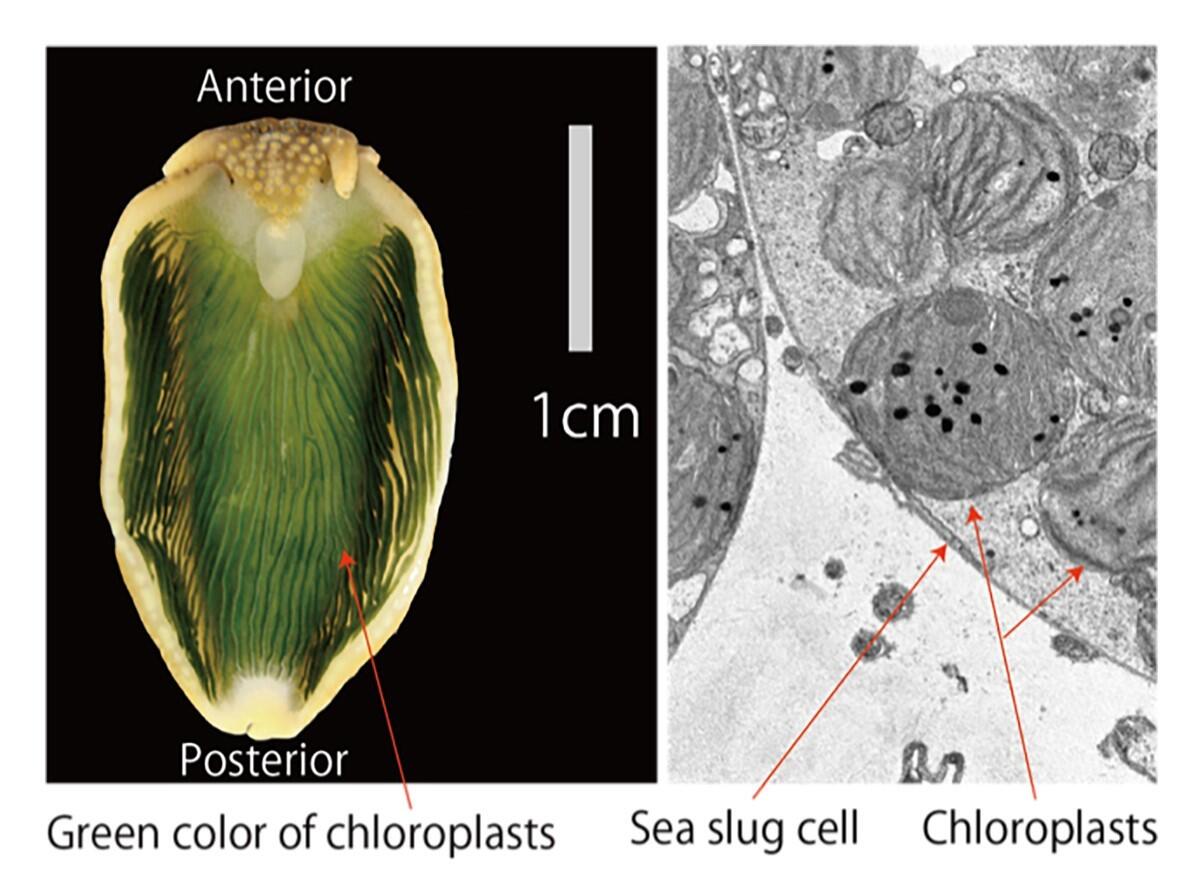Mysteriously, one species of sea slug can obtain nutrition through the process photosynthesis, despite being animals. They conduct photosynthesis using chloroplasts taken up from algae, but how do they maintain these fragile chloroplasts for months? It has been suggested that they may take up part of the algal genome by horizontal gene transfer, but there has been no definite evidence of this occurring.
A research group led by Researcher Taro Maeda (currently a postdoctoral researcher at Ryukoku University and a member of the Institute for Advanced Biosciences at Keio University) and Professor Shuji Shigenobu of the National Institute for Basic Biology has successfully sequenced the genome of the representative kleptoplastic sea slug, Plakobranchus ocellatus, with high accuracy. By comparing this genome with the previously sequenced genomes of Elysia marginata and the prey algae, they found for the first time that the algal genes involved in photosynthesis had not been transferred to the cell nuclei of sea slugs. This indicates that under a specific environment, chloroplasts can function for a certain period of time, even in organisms without photosynthesis-related genes. As explained by Professor Shigenobu,"In this study, we found that these sea slugs had evolved to maintain the chloroplasts that they had taken up for a long period of time, rather than using horizontal gene transfer, which was against the prevailing theory. Learning the survival system of sea slugs may contribute to innovations for improving the global environment, such as energy production using photosynthesis." The findings of this research were published in eLife.
Some sea slugs take up chloroplasts from the algae that they consume as food and use them to perform photosynthesis in their body. Because some of the algae consumed by Plakobranchus ocellatus are multinucleate unicellular organisms (e.g., Caulerpa lentillifera), the sea slugs can directly ingest the intracellular organelles of the algae, including chloroplasts, by sucking the algal cell contents. Whereas many of the algal organelles are digested, the chloroplasts are taken up by the intestinal cells of the sea slug without being destroyed. The intestines of Plakobranchus ocellatus, which spread around the body like blood vessels, take up chloroplasts and turn green wherever photosynthesis occurs. This system, called kleptoplasty, was first discovered by the Japanese researcher Shiro Kawaguchi in 1965.

(Source: National Institute for Basic Biology)
Chloroplasts require photosynthetic proteins to perform photosynthesis. Because photosynthetic proteins are fragile, chloroplasts isolated from algae lose their function within a few days in a test tube. However, their function is maintained in sea slugs for several months. Although the proteins that are synthesized and supplied to the cell are normally translated from the nuclear genome, photosynthetic proteins should not be encoded in the nuclear genome of sea slugs, as slugs are animals that normally lack these functions. As a result, it had been hypothesized that the necessary genes were transferred from the algae to the cell nuclei of sea slugs during evolution (the theory of horizontal gene transfer), but this remained unproven without evidence.
This is because a method for extracting high-quality sea slug genomic DNA that can withstand genome sequencing had not been established. Furthermore, the construction of highly accurate genomic information that can validate horizontal gene transfer is challenging. There were also other problems, including a lack of information on the species of algae consumed as food and insufficient information on photosynthetic gene sequences.
This research group successfully sequenced the genome of Plakobranchus ocellatus. As explained by Maeda,"To obtain accurate genomic information, we need DNA that is as long as possible. Because the normal DNA acquisition method usually leads to sequence fragmentation, we manually repeated the CTAB method many times to obtain clean and long DNA sequences for study."
DNA sequencing revealed the genome of Plakobranchus ocellatus to be composed of 930 million base pairs (about one third of the human genome). However, a comprehensive search did not detect any alga-derived photosynthesis-related genes in its genome. The researchers also applied the same search method to the genome of the algae (Caulerpa lentillifera) to ensure that the result was not due to insufficient sensitivity of the search method. The detection of 73-93% of the photosynthesis-related genes demonstrated that the search method had sufficient detection sensitivity. They eventually expanded the search range not only to the constructed genome sequence of sea slugs but also to raw data and gene expression data (RNA-Seq), but they could not obtain any evidence to support the horizontal gene transfer of photosynthesis-related genes. From these results they concluded that horizontal gene transfer from the algal genome to the Plakobranchus ocellatus genome had not occurred.
In this study, the research group sequenced the genomic DNA in kleptoplasts taken up by Plakobranchus ocellatus, in addition to the nuclear genome. This is the first genome sequencing of kleptoplasts reported in the world. Examination of the genetic repertoire contained in the genomes revealed that the characteristics of kleptoplast genomic DNA are similar to those of chloroplasts of many algae. It encodes approximately 60 genes and does not contain the ones in the nuclear genome of normal algae that are essential for photosynthesis. This indicates that no unique evolutionary process has occurred in the genome of kleptoplasts to allow photosynthesis in animal cells.
The molecular mechanism of trait propagation without horizontal gene transfer remains unknown. However, gene expression analysis of the photosynthetic organ (hepatopancreas) of Plakobranchus ocellatus showed that genes related to protein metabolism, oxidative stress tolerance, and innate immunity may be involved in the maintenance of photosynthetic activity. This suggests that the genes related to oxidative stress tolerance may protect photosynthesis-related proteins from the stress caused by photosynthesis.
In the future, the research group aims to conduct further studies to uncover the conditions that allow for the maintenance of photosynthesis for a long period of time.
This article has been translated by JST with permission from The Science News Ltd.(https://sci-news.co.jp/). Unauthorized reproduction of the article and photographs is prohibited.




